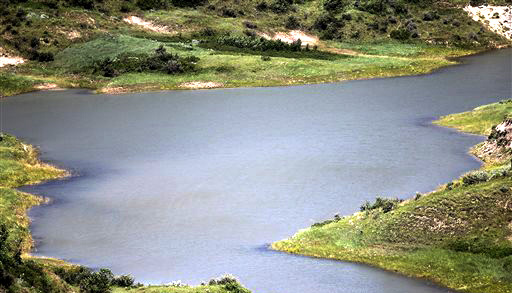
An underground pipeline in Mandaree, North Dakota spilled one million gallons of tainted saltwater after it leaked sometime during the fourth of July weekend. The saltwater is a byproduct of oil and natural gas production, and contains traces of chemicals used in fracking. The mess has since stretched 8,240 feet – down a steep ravine and dangerously close to a lake that serves as the natural water source for a Native American reservation.
Lake Sakakawea, a reservoir of the Missouri River, provides drinking water to several communities on the Fort Berthold Native American reservation including the Manda, Hidatsa and Arikara tribes.
The pipeline is owned by Arrow Pipeline LLC, a subsidiary of Crestwood Midstream Partners, Inc. Company officials have admitted that the spill has already severely damaged trees, shrubbery, and grasses with possible negative health effects on local wildlife still being ascertained. The area is considered one of the worst spots for such a spill, because of the rough topography and sensitive ecosystem. In fact, the inaccessible terrain has forced crews to carry cleanup equipment to the area by hand, slowing the recovery process.
The EPA arrived to assess the site on July 10, in order to make sure the saltwater had not reached the lake, which is essentially the lifeblood of the reservation. Officials with the agency said beaver dams had been poisoned by the mixture, and that it had pooled up on the ground and soaked into the soil. It was predicted that cleanup will likely take many weeks.
However, the fact that the saltwater has not reached the lake is not due to the help of Crestwood. The Three Affiliated Tribes, an organization that represents the three local tribes, took it upon themselves to erect a barrier between the toxic spillage and their pristine water. “We have a berm and a dike around Bear Den Bay,” which leads to Lake Sakakawea, “to keep it from going into the lake,” said Three Affiliated Tribes chairman Tex Hall.
Kris Roberts, an environmental geologist with the North Dakota Department of Health, said the spill was significant and damaging. He remarked, “We’ve got dead trees, dead grasses, dead bushes, dying bushes.”
The area involved is in the hear to the state’s oil boom patch. The number of saltwater spills in the state has grown in tandem with its oil development, as well as the rate of pure oil spills. In 2012, there were 141 pipeline leaks reported – 99 of them spilled 8,000 barrels or more of saltwater. For the Native Americans’ part, this latest incident has rattled them – and a worse one could happen and end up truly polluting their only clean water source.
“Along with many others in Western North Dakota, I drink water from Lake Sakakawea,” said Theodora Bird Bear, a Dakota Resource Council member from the area. Her view of the matter, like that of many others, was not optimistic. “With 13 oil pipelines crossing the bottom of the lake,” she said, “I expect it is a matter of when, not if, there’s a major spill.”
Photo: Bear Den Bay – the only thing currently separating the saltwater spill from the sensitive Lake Sakakawea. AP












Comments